Species †G. erlianensis | Scientific name Gigantoraptor | |
 | ||
Similar Oviraptor, Oviraptorosauria, Microraptor, Utahraptor, Alectrosaurus | ||
Pivot battle arena gigantoraptor vs deinocheirus
Gigantoraptor is a genus of giant oviraptorosaurian theropod dinosaur.
Contents
- Pivot battle arena gigantoraptor vs deinocheirus
- Cbeebies andy s dinosaur raps gigantoraptor
- Description
- Discovery and naming
- Classification
- Paleobiology
- References
Cbeebies andy s dinosaur raps gigantoraptor
Description
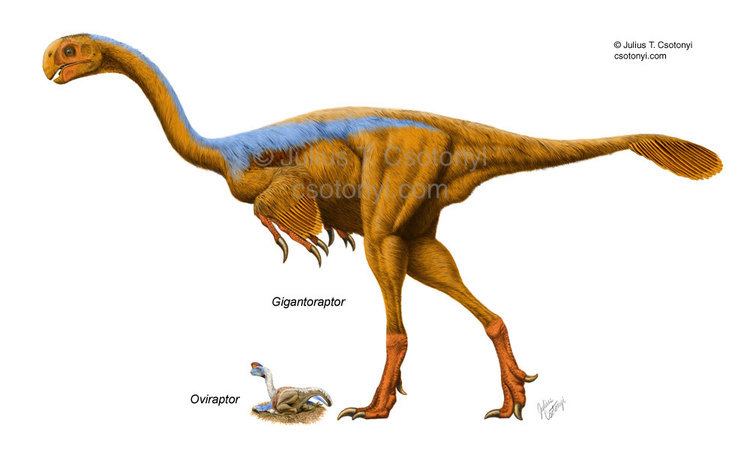
It was clear to Xu et al. that Gigantoraptor belonged to the Oviraptorosauria, a group named after Oviraptor, but compared to other known members, Gigantoraptor was much larger, approximately three times as long and 35 times more massive than the heaviest earlier discovered oviraptorosaurid Citipati. Xu et al. estimated the length at 8 metres (26 ft) and the weight at 1400 kilogrammes. In 2010, Gregory S. Paul even gave an estimate of two tonnes (2.2 tons).

The toothless lower jaws of Gigantoraptor are fused into a broad shovel-like mandibula. They indicate that the unknown skull was over half a metre long and toothless also, probably equipped with a horny beak. The front tail vertebrae have very long neural spines and are heavily pneumaticised with deep pleurocoels. The middle section of the relatively short tail is somewhat stiffened by long prezygapophyses. The back tail vertebrae are lightened by spongeous bone. The front limb is rather long because of an elongated slender hand. The humerus is bowed outwards to an exceptionally large extent and has a very rounded head. The first metacarpal is very short and carries a strongly diverging thumb. The hindlimb is also long because of an elongated lower leg. The thighbone is relatively slender and short with a distinct head and neck. The foot is robust with large and strongly curved toe claws.
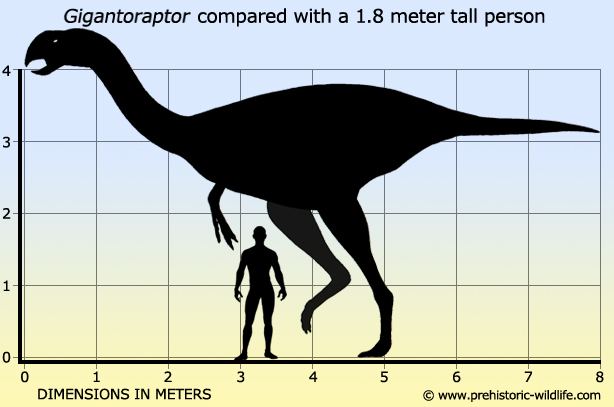
No direct evidence of feathers was preserved with the skeleton, but Xu et al. (2007) discussed their likely presence on Gigantoraptor. They admitted that despite Gigantoraptor being a member of the Oviraptorosauria, a group that includes the feathered species Caudipteryx and Protarchaeopteryx, it might have been "naked" because it is three hundred times as massive as these species, and very large animals may rely more on mass for temperature regulation, losing the insulating coverings found on their smaller relatives. However, they suggested that at least arm feathers were probably still present on Gigantoraptor, since their primary functions, such as display and covering the eggs while brooding, are not related to the regulation of body heat.
Discovery and naming

In a quarry at Saihangaobi, in Sonid Left Banner (Inner Mongolia), numerous remains of the sauropod Sonidosaurus have been uncovered since 2001. Chinese paleontologist Xu Xing was asked to reenact the discovery of Sonidosaurus in April 2005 for a Japanese documentary. Xu obliged them by digging out a thighbone. As he wiped the bone clean, he suddenly realized it was not from a sauropod, but from an unidentified theropod in the size class of Albertosaurus. He then stopped the filming to secure the serendipitous find. This way, the discovery of the Gigantoraptor holotype fossil was documented on film.
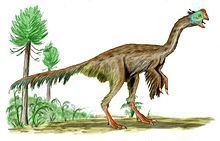
In 2007, the type species Gigantoraptor erlianensis was named and described by Xu, Tan Qingwei, Wang Jianmin, Zhao Xijin and Tan Lin. The generic name is derived from Latin gigas, gigantis, "giant" and raptor, "seizer". The specific name refers to the Erlian Basin.
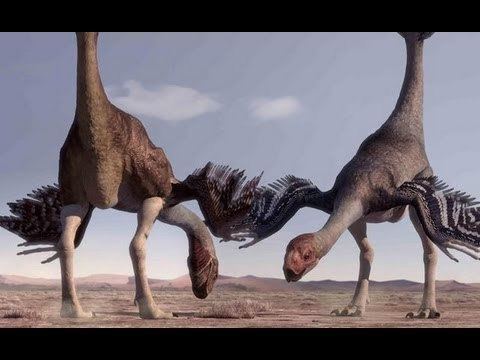
The only known type specimen, LH V0011, was discovered in 2005 in the Iren Dabasu Formation, Erlian basin, in Inner Mongolia. The age of the Iren Dabasu Formation is controversial; based on ostracods, Godefroit suggested the unit was equivalent to the Nemegt Formation, or about 70 Ma, though some vertebrate remains suggest an older Santonian age, between 84 and 86 Ma. It consists of the incomplete and disassociated remains of a single subadult individual, a partial skeleton lacking the cranium but including the lower jaw, a single neck vertebra, most of the back and tail and the majority of the frontlimb and hindlimb elements.
Classification
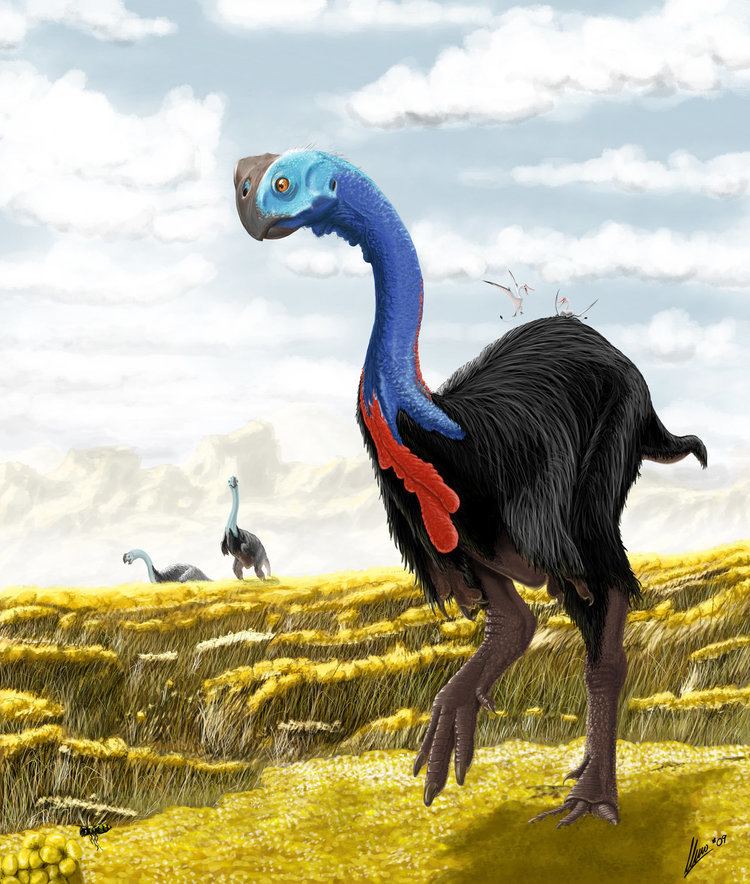
In 2007, Xu et al. assigned Gigantoraptor to the Oviraptoridae, in a basal position. The anatomy of Gigantoraptor includes the diagnostic features of the Oviraptorosaurs. However, it also includes several features found in more derived eumaniraptoran dinosaurs, such as a frontlimb/hindlimb ratio of 60%, a lack of expansion of the distal scapula and the lack of a fourth trochanter on the thighbone. Despite its size, Gigantoraptor would thus have been more bird-like than its smaller oviraptorosaurian relatives.
In 2010, a second analysis of Gigantoraptor relationships found it to be a member of the Caenagnathidae rather than an oviraptorid. Phylogenetic analysis conducted by Lamanna et al. (2014), supported that Gigantoraptor was a basal caenagnathid. The cladogram below follows an analysis by Longrich et al. in 2013, which found Gigantoraptor to be a Caenagnathid.
Paleobiology
The diet of Gigantoraptor is uncertain. Although some oviraptorosaurs, such as Caudipteryx and Incisivosaurus, are thought to have been mostly herbivorous, Gigantoraptor had long hind legs with proportions that allowed for fast movement (it was probably more nimble than the larger and less agile Tarbosaurus), and large claws, a combination that is not usually found in herbivores of this size. Paul suggested that Gigantoraptor was also a herbivore and used its speed to escape predators.
The specimen has advanced ossification and growth rings in the fibula that indicate it was likely eleven years of age when it died. It appears to have reached an early young adult stage at age seven, and probably would have grown much larger when it reached the adult stage. This indicates a growth rate that is faster than in most large non-avian theropods.
The existence of giant oviraptorosaurians, such as Gigantoraptor, explains several earlier Asian finds of very large, up to 53 centimetres long, oviraptorosaurian eggs, assigned to the oospecies Macroelongatoolithus carlylensis. These were laid in enormous rings with a diameter of three metres. The presence of Macroelongatoolithus in North America indicates that gigantic oviraptorosaurs were present there as well, though no fossil skeletal remains have been found.
